2023 Zandvoort Historic Grand Prix report
Sunscreen, umbrellas and heated racing action
Author
- Mattijs Diepraam
Date
- June 21, 2023
Related articles
- Zandvoort - The quintessential GP track in the dunes, by Mattijs Diepraam
- Zandvoort - Historic crowd-puller, 2012 Historic GP report, by Mattijs Diepraam
- Zandvoort - Treasure in the dunes, 2013 Historic GP report, by Mattijs Diepraam
- Zandvoort - Seaside sensations, 2014 Historic GP report, by Mattijs Diepraam
- Zandvoort - Lucky stars, 2015 Historic GP report, by Mattijs Diepraam
- Zandvoort - Down to the wire, 2016 Historic GP report, by Mattijs Diepraam
- Zandvoort - Dune tragedy, 2017 Historic GP report, by Mattijs Diepraam
- Zandvoort - Epic sand fights, 2018 Historic GP report, by Mattijs Diepraam
- Zandvoort - Miracle in the dunes, 2020 Historic GP report, by Mattijs Diepraam
- Zandvoort - The boys were back in town, 2022 Historic GP report, by Mattijs Diepraam
- Zandvoort - Close contests, 2024 Historic GP report, by Mattijs Diepraam
- Zandvoort - Pass the Dutchie on the left-hand side, 2025 Historic GP report, by Mattijs Diepraam
Who?Mike Cantillon, Jonathan Holtzman What?Williams-Cosworth FW07C, Tyrrell-Cosworth P34 Where?Zandvoort When?2023 Historic Grand Prix (June 17, 2023) |
 |
Why?
Now hosted for a second time by the same organisers responsible for the modern Dutch Grand Prix, Zandvoort’s Historic Grand Prix returned in an unfamiliar June slot on the historic calendar – but those who are aware will know that the Dutch GP used to be run in June for several years in the past. The sun was out in full force, adding to the beachside atmosphere that created a vibrant buzz among the 25,000 spectators flocking to the main historic event on Dutch soil. It wasn’t hard to spot the attraction, as no less than 29 historic 3-litre Formula One cars were entered for not two but three races on the weekend.
The heat did leave its trails in the minds of various drivers in the Masters Racing Legends series for 1966-’85 Formula One cars, as much of the racing time went to waste on safety-car periods and red flags. But during the minutes of actual racing, the action was as exciting as you could imagine, as on Friday the first seven cars were covered by no more than three seconds until a few laps from the end. Once the dust had settled, Britec teammates Michael Lyons (Lotus 92) and Nick Padmore (Lotus 77) powered away from the front row to claim a solid 1-2 for the German team, followed home by Mike Cantillon (Williams FW07C), who happily picked up rights for the third step on the podium that was earmarked for Jamie Constable’s until his Tyrrell 011B dropped out in the dying moments of the race. Matt Wrigley rose from tenth to fourth in his Penske PC3, taking second place behind Padmore in the pre-78 class, while Ken Tyrrell salvaged sixth behind Pierre-Brice Mena (Fittipaldi F8) after a spin on cold tyres early on in which the American threw away his fourth place.
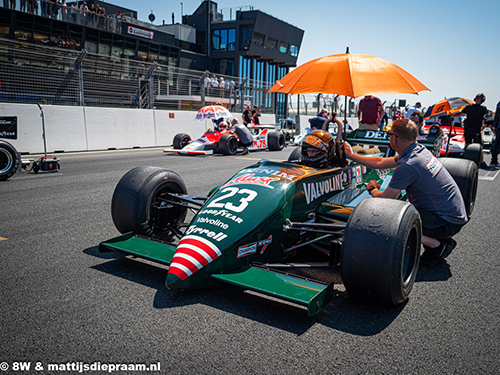
Ken Tyrrell took his debut win on Saturday and then added a second victory on Sunday. (photo 8W)
The retirements also included reigning champion Steve Hartley, for whom it has been a torrid season so far. Changing his starting number from 1 back to 77 failed to change his luck, as a disappointing qualifying session was followed up by his McLaren MP4/1 going straight on into the barriers at Gerlach corner. That was shortly after the Cosworth in the back of that other MP4/1 blew up in spectacular fashion, with the result that Arthur Bruckner’s A6 tripped up when the Austrian hit Mark Higson’s oil trail in the Hans Ernst chicane.
The real chaos did not ensue until Saturday, but when it did it happened right at the start, as Jonathan Holtzman in the Tyrrell P34 began squeezing Peter Williams’ Lec CRP1 on the run-up to the Tarzan. However, Williams should not have been sitting there according to the gentlemen’s agreement common in all Masters classes which effectively created a yellow-flag situation in the first three corners of a race. It’s there to prevent unnecessary damage to the precious cars but now, that unnecessary damage was suffered after all, as the Lec scooped up the six-wheeler whereupon the cars slammed hard into the crash barrier on the left. Both men were extremely angry with each other and their frustration over the hefty repair bills simmered long after.
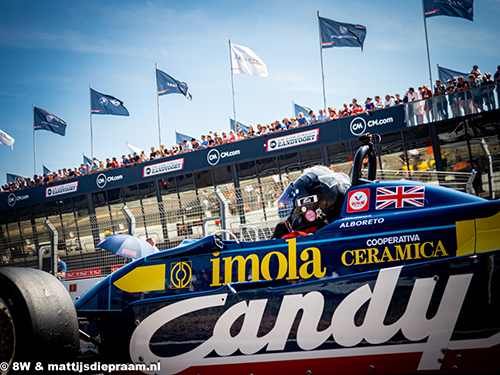
The event attracted a large crowd. (photo 8W)
The safety car period lasted well over 11 minutes, leaving less than eight minutes of racing. After the restart, Mena then proved too keen in his overtaking move around the outside at Tarzan, resulting in another trip into the gravel. This time the red flag came out, after which the race director, in consultation with the stewards, decided to turn the race clock back to 10 minutes. An unusual but practical and sensible decision.
Tyrrell then managed to pass teammate Warren Briggs while moments later which Wrigley also nipped past the New Zealander in the McLaren M29. Wrigley was unable to threaten Tyrrell but did win the pre-78 class. Mike Cantillon was third once again, although he failed to see the end of the race, as at Scheivlak he dipped one foot into the sand, spinning the Williams around before it hit the crash barrier with its rear wing. As the car came to a halt in the middle of the track, the red flag had to be called again. Now just one minute remained, so that was the end of the race. As in any aborted race, the results is declared on countback to the standings of the last lap completed, and so the Irishman still got to celebrate his podium.
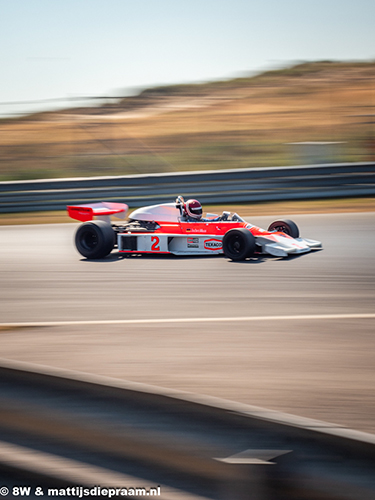
Quite all of a sudden, Dutch government officials enforced a strict anti-tobacco advertisement policy that like in France now also applied to historic cars. (photo 8W)
Briggs, meanwhile, bravely held his own against Padmore and Lyons and on the podium he was happy to take a stab at the likely cause – he borrowed his friend Cor Euser’s overall, as his own overall had failed to pass technical scrutineering. Pointing to the groin area, the Kiwi dryly observed: “Cor’s are very roomy here, so no doubt that helped...”
On Sunday, Tyrrell went into repeat mode, this time starting from pole. Yet the American did not get his second victory wrapped as a gift, because on the back of mid-race safety-car period, Wrigley managed to outrace him on the restart. The reason was clear, though – Tyrrell had put his foot down in the Arie Luyendijk corner – the corner where the oil trail that had caused the neutralisation was located – but his car went sideways on the cement dust. This was an invitation to Wrigley to take advantage but the young Briton missing a gear allowed Tyrrell to retake the lead and claim the win.
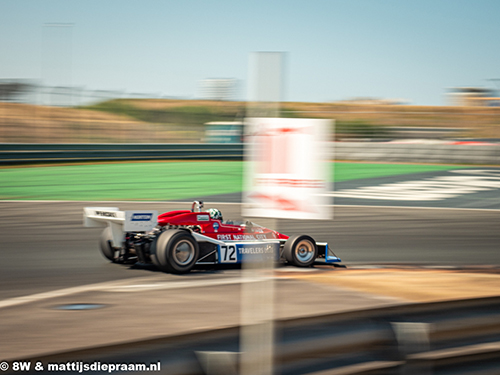
Despite qualifying only tenth, Matt Wrigley bounced back from his qualifying issues to take a fourth, two second places and a pair of pre-78 class wins. (photo 8W)
Wrigley’s tyres were well past their prime towards the end, so the Penske PC3 was put under pressure from Padmore who was keen to pry the pre-78 class victory from Wrigley’s hands. He was close, but it was not enough – a mere 0.115 seconds separated the pair at the finish. Lyons had a grandstand seat to secure his third post-82-class victory with fourth place. Following Lyons home was young Werner d'Ansembourg, who made his presence felt in his debut in historic Formula 1. Christophe’s son finishede very race in his father’s Williams FW07C while fifth place was the crowning achievement of a strong debut weekend.
As the Historic Grand Prix celebrated the circuit’s 75th anniversary, with Grand Prix cars part of that from the very beginning, the two races for pre-66 Grand Prix cars were actually as important to the event as the 29 F1 cars from the 1966-'85 era that proved to be the big crowd-pleasers.
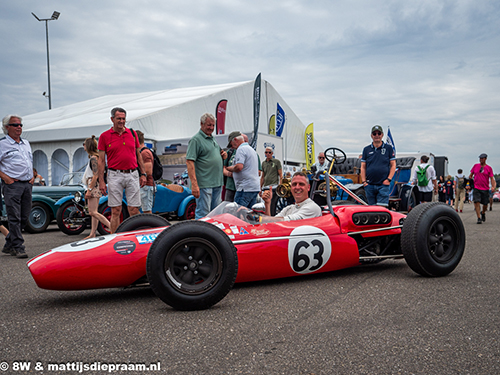
On home soil, Dutchman Michel Kuiper won for the first time in HGPCA, and despite failing to do so again the next day was still extremely happy with second place. (photo 8W)
It was therefore gratifying that the Historic Grand Prix Car Association was able to welcome a Dutch winner for the first time in its history – and he had waited long enough for it. Although Michel Kuiper had been fast from his debut and soon also achieved several podiums, a HGPCA victory had remained elusive. Even at his home, he could not expect to win, since despite the absence of several rivals such as Justin Maeers, Tim Child and Michael Gans, the series’ fastest driver would still be there. What’s more, Kuiper was also forced to start with a brand new engine when his previous Climax unit had failed at Dijon the week before.
So, as expected, Will Nuthall took pole with ease, but Kuiper did manage to haul his Brabham BT4 up onto the front row. Luck then smiled on him on Saturday, when Nuthall’s Cooper T53 fell off to hand Kuiper the lead. A late safety car left him to deal with Mark Shaw’s Lotus 21 and Andy Willis in the Lotus 24 breathing down his neck but a good restart helped put him out of reach. The following day, however, there was no stopping Nuthall who stormed through the entire field to eventually outrun Kuiper as well. A safety car made life a touch easier for Nuthall but even without the aid of a caution period the young Briton would have done it. For a few laps he put up a show with Kuiper in front of a jubilant crowd before checking out at the front.
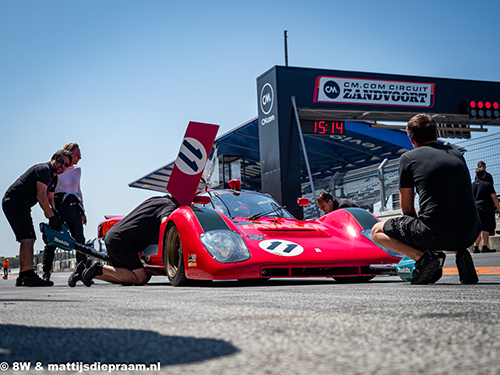
Father and son David & Olivier Hart wooed their home crowd with victory for the mighty Ferrari 512M continuation car in the first Masters Sports Car Legends race. (photo 8W)
In the Masters Sports Car Legends, David & Olivier Hart ran off with the Saturday win in their brilliant Ferrari 512M continuation, although Hart Sr still had to deal with the Chevron B26 of newly returned Henry Fletcher during his stint. Yet Hart was not truly worried about that, as he said the car was fast enough in the important bits – the straights – to keep Fletcher at bay. When Fletcher dropped out, Olivier had free rein to drive home the win, well ahead of the Lola T70 Mk3Bs of Steve Brooks and Jason Wright.
The next day, though, Hart was hit by bad luck when he was forced to come in for a puncture. The puncture in itself already being a setback, the wheel turned out to be firmly attached to the hub. This handed the led to Brooks but in the meantime Fletcher had made some serious inroads while coming from the back. A brilliant battle ensued between the two in which the lead changed several times due to mistakes back and forth. Still, Brooks seemed to have the upper hand thanks to his 5-litre Chevy, until Fletcher piled on so much pressure that Brooks made a mistake on the final lap. Thus, the Chevron prevailed after all.

Nigel Greensall took pole in John Spiers' TVR Griffith but a broken exhaust and a stuck throttle prevented him from an attempt to catch the Daytona Cobras up front. (photo 8W)
Olivier Hart took his second win of the weekend in the combined race of the Masters Gentlemen Drivers for GT cars up to 1966 and the Masters Pre-66 Touring Cars. In the other Shelby Cobra Daytona Coupe, Calum Lockie and Julian Thomas were their biggest rivals, as the two Cobra Daytonas proved to be quicker than the four TVR Griffiths in the field. Lockie started this time, as Thomas would do the opening stint in his Ford Falcon in the touring-car section. The Scottish pro driver opened up a modest gap on young Hart, but the latter knew that Lockie was facing a longer pit stop time due to his elite-driver status.
As a result, Thomas was on the back foot but these days the British electronics entrepreneur is almost as good as Lockie and managed to catch Hart with 15 minutes remaining on the clock. The decisive passing move came too, but then Thomas went deep into Tarzan allowing Hart to temporarily retake the lead. Precisely at that moment, the safety car was called, followed a few seconds later by a red flag. So Hart was saved by the bell, but you need to have luck on your side once in a while, he said afterwards. Thomas, meanwhile, regretted his mistake, but with the help of teammate Andy Wolfe did manage to win the touring-car race.
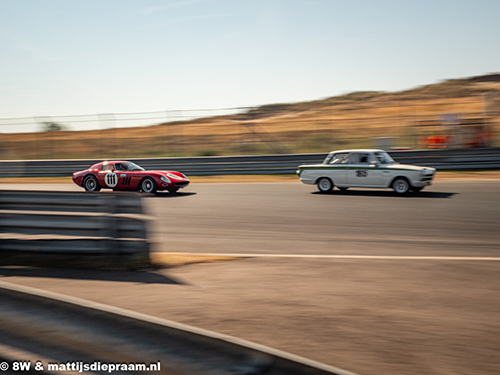
Roelofs Engineering brought back its self-built Ferrari 250 GTO '64, but the car was unable to feature. Van der Lof withdrew the machine after his friend required medical assistance in the pitlane. (photo 8W)
The race was stopped for half an hour in the early stages when a competitor sent his car into the pits where he reported feeling unwell. His condition was immediately recognised by Sophie Schryver, one of Masters’ race coordinators, who then immediately made race director Chris Norman aware of the severity of the situation. The latter immediately waved the red flag. This allowed the emergency services to attend to the driver in the pits. From the hospital later came the news that the driver was doing relatively well – quite reassuring after such a scare. The quick and adequate action of everyone involved is to be highly commended.
The Masters Endurance Legends was sadly missing the Peugeots that had been the cream of the previous races – Brooks’ 90X still suffered from the gearbox damage that had cost him a win at Hockenheim, while Stuart Wiltshire and Richard Meins had not travelled from England. This allowed Belgian driver Christophe d’Ansembourg to seize the moment, or at least it looked that way – were it not for the fact that a driveshaft snapped on his Lola-Aston Martin DBR1-2 on Saturday, handing Marco Werner and his Lola-Judd B12/80 the win on a plate.
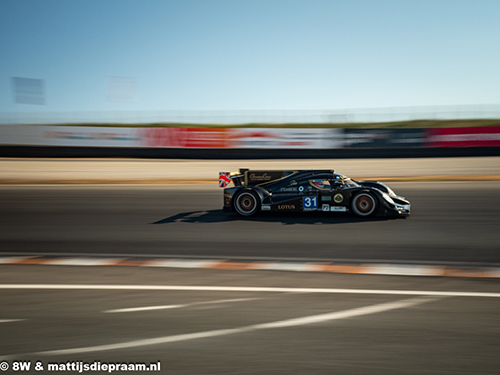
in his LMP2 Lola, Marco Werner inherited the Saturday win but had no defense against Christophe d'Ansembourg's Aston Martin V12-powered LMP1 Lola on Sunday. (photo 8W)
So the next day, d'Ansembourg was forced to come from behind. The Belgian did so in a quick and decisive way, so his LMP1 had soon reached Werner’s LMP2 in the lead. After the pass, the German stayed close, but d'Ansembourg was calmly managing his lead. Cor Euser could actually do the same both days, except that Euser and his newly restored Marcos LM600evo were not built for that. This resulted in two resounding class wins for the car that had such a sad ending at the time. Not even a stop-and-go for a jumped start could stop Euser on Saturday.
Euser also starred as a guest driver in the Masters GT Trophy. His main opponent was Craig Wilkins, who did win the Friday afternoon race supremely, but when his Lamborghini Huracán Super Trofeo Evo snapped a driveshaft, Euser took the win. It did not earn him a podium, as the Dutchman competed hors concours, so the championship points went to Ron Maydon in a non-Evo-spec Super Trofeo.
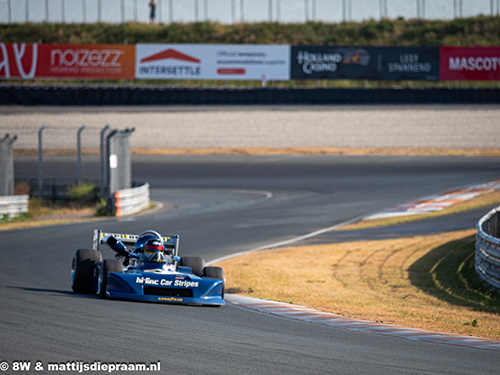
Wolfgang Kauffmann won the second F2 race on board the ex-Stephen South March 782. (photo 8W)
No Dutchmen in Formula 2, but did that contribute to Saturday’s race becoming a concatenation of safety cars and red flags? In the end, Andrew Smith was able to triumph in one of the March 782s in the field. Smith was initially threatened by Wolfgang Kaufmann in the 782 that once belonged to Stephen South, but at the end Kyle Tilley was second in the Ralt RT1 in which he was making his debut. Brian Morris was third in another 782. Kaufmann did win quite easily on Sunday, especially after both Smith and Tilley had to retire. The German was followed home by two other 782s, those of Morris and Marc Devis.
No less than 27 cars had arrived for two 1000cc F3 races. The field was able to be so large because Zandvoort is located exactly between England and France, allowing the British and French series to run together. Samuel Harrison (Brabham BT21B) and Jeremy Timms (Chevron B15) occupied the first two places on both days, while François Derossi (Chevron B17) was the fastest Frenchman.
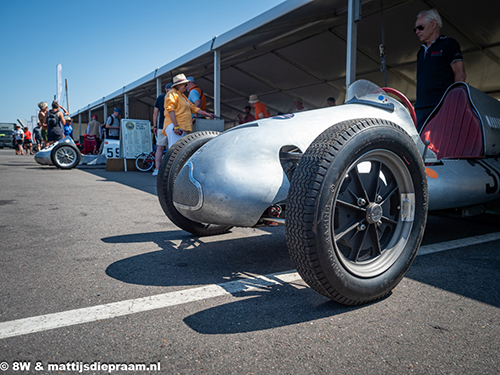
The 500cc Formula 3 band were the kings of paddock atmosphere. (photo 8W)
Meanwhile, the 500cc F3 racers provided plenty of atmosphere in the paddock. Tinkering with and starting these methanol-fuelled single-seaters constituted a spectacle in itself. In the first race, Peter de la Roche was the long-time leader with his Cooper Mk5 but when the young Brit was forced to retire on the penultimate lap, James Wilson in a Cooper Mk10 took home the win, followed at an appropriate distance by Xavier Kingsland and Simon Dedman, both on a Staride Mk3. In the second race, it was James Wilson’s turn to be unlucky, allowing Peter de la Roche to take the win. Family honour was saved by Chris Wilson who brought his Mackson MS001 to the finish line in second place, followed by Richard Kelly on Cooper Mk5.
The biggest field of the weekend was produced by the NK GTTC, as the Dutch GT and touring car championship for 1966-’81 cars was joined by MG/Triumph Competitions. Fastest in practice, Hans de Graaf could not cash in on his pole, as it was Wim Kuijl who took the win in the Ford Capri RS3100 after a very exciting race. De Graaf did manage to stay ahead of Daniel Schrey in a similar Porsche 911 RSR. On Sunday, the Belgian St Paul Racing Team did it again, and now Wim Kuijl was seconded on the podium by father Dieter in another Capri that fought off De Graaf and Schrey in their Porsches.
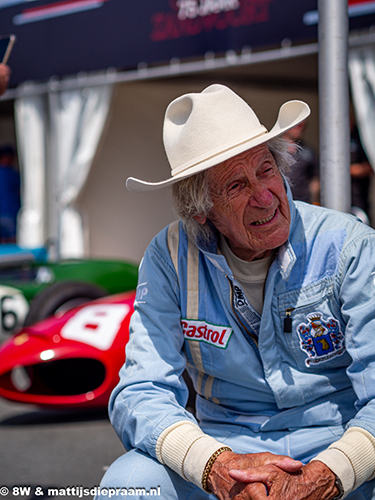
Arturo Merzario once again proved a popular star in the demos, showing off Jason Wright's Ferrari 156 'Sharknose' recreations with gusto. (photo 8W)
In the Dutch touring car championship for ’82-’90 cars, Pieter Bikker proved invincible once more, as his Group A BMW E30 325i remains undefeated so far this season. However, Maarten Boon in a similar BMW 325i is getting closer and closer.
The event was also graced by various demos from Porsche, FORCE F1 and an array of car clubs such as that of DAF. Another regular feature in the timetable were the four regularity runs of the Dutch Vintage Sports Car Club. Now located at Hans Ernstbocht, the paddock of the enthusiast club for pre-war cars once again proved to be a much-visited corner. The Albada Jelgersma family won two stages, Mark one in the mighty Bugatti T57 Stelvio, Jeroen the other with the Bugatti T40 Grand Sport, while Diederik Klopper in his Bugatti T35B completed the Molsheim dominance with victories in the other two stages.
